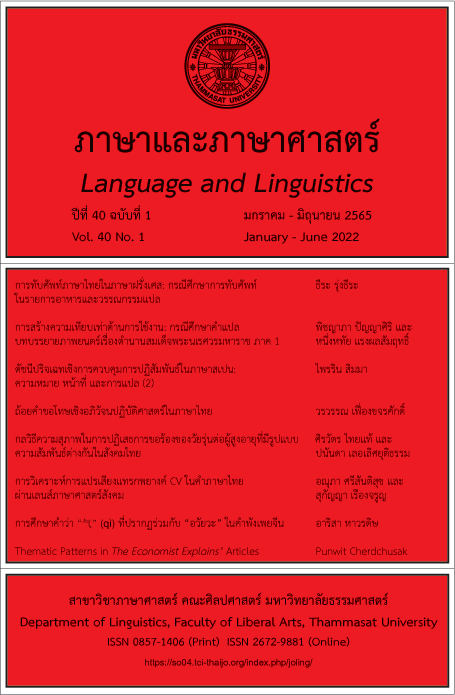An Account of Variation on CV Epenthesis in Thai Words through the Lens of Sociolinguistics
Main Article Content
Abstract
The objective of this paper is to investigate the free variation of CV epenthesis through the lens of sociolinguistics in Thai words focused on the occurrence of its variants according to three variables: (i) age, (ii) the speaker’s education background, and (iii) style. The data was collected from 135 native Thai speakers, aged from 20 to over 60 years, with a range of educational backgrounds including undergraduate, Bachelor’s degree, and upper-level Bachelor’s degree. Two styles were selected for this study: (i) conversation representing the informal style and (ii) word lists representing the formal style. The data were analyzed using a one-way ANOVA and a Chi-square Test (χ2-test). The results revealed that age in terms of style showed that younger people (20-30 years) preferred CV deletion over CV epenthesis, whereas the oldest group (40-50 and over 60 years) preferred CV epenthesis to CV deletion. Regarding, educational background, the results suggest that a higher percentage of speakers at the undergraduate level preferred CV deletion while a higher percentage of speakers at the Bachelor’s degree and upper Bachelor’s degree level preferred to use CV epenthesis. The results also showed that style had an impact on the variation. With informal style, a greater proportion of speakers preferred to use CV deletion; however, when the context required a formal style, it was elicited by prompting the speakers to use variation more carefully. Thus, this research shows that the speakers prefer to use CV epenthesis when using a formal style.
Article Details

This work is licensed under a Creative Commons Attribution-NonCommercial-NoDerivatives 4.0 International License.
บทความทุกบทความเป็นลิขสิทธิ์ของภาษาและภาษาศาสตร์
References
จุฬาลงกรณ์มหาวิทยาลัย. (2563). คลังข้อมูลภาษาไทยแห่งชาติ ในพระราชูปถัมภ์สมเด็จพระเทพรัตนราชสุดาฯ สยามบรมราชกุมารี. http://www.arts.chula.ac.th/ling/tnc3
ปาลีรัฐ ทรัพย์ปรุง. (2537). การแปรของเสียง (h) ในภาษาถิ่นสงขลา เขตชุมชนเมือง ตามปัจจัยทางสังคม [วิทยานิพนธ์ปริญญามหาบัณฑิต]. จุฬาลงกรณ์มหาวิทยาลัย.
พนิดา ธนานันท์. (2545). ความสัมพันธ์ระหว่างการแปรของ ร, ล ในการพูดและการเขียนสะกดคำ: การศึกษาตามแนวภาษาศาสตร์สังคม [วิทยานิพนธ์ปริญญามหาบัณฑิต]. มหาวิทยาลัยศิลปากร.
พิมพ์ระวี เรืองวัฒกี. (2551). การแปรทางสังคมของพยัญชนะควบกล้ำ (kw) และ (khw) ในภาษาไทยถิ่น ตำบลบ้านแพรก อำเภอบ้านแพรก จังหวัดพระนครศรีอยุธยา [วิทยานิพนธ์ปริญญามหาบัณฑิต]. จุฬาลงกรณ์มหาวิทยาลัย.
ราชบัณฑิตยสถาน. (2539). พจนานุกรมฉบับราชบัณฑิตยสถาน พุทธศักราช 2525. อักษรเจริญทัศน์.
ราชบัณฑิตยสถาน. (2556). พจนานุกรมฉบับราชบัณฑิตยสถาน พุทธศักราช 2554. นานมีบุ๊คส์พับลิเคชั่นส์.
ศิริรัตน์ ศิริวิสูตร. (2537). การแปรของเสียงพยัญชนะท้าย (l) ในคำยืมภาษาอังกฤษในภาษาไทยตามวัจนลีลาและพื้นฐานการศึกษา [วิทยานิพนธ์ปริญญามหาบัณฑิต]. จุฬาลงกรณ์มหาวิทยาลัย.
Aronoff, M., & Fudeman, K. (2011). What is morphology? (2nd ed.). Wiley- Blackwell.
Brown, L. (2015). Revisiting “polite” -yo and “deferential” -supnita speech style shifting in Korean from the viewpoint of indexicality. Journal of Pragmatics, 79, 43-59.
Childs, C. (2019). Interviewer effects on the phonetic reduction of negative tags, innit?. Journal of Pragmatics, 142, 31-46.
Coupland, N. (2011). The sociolinguistics of style. In R. Masthrie (Ed.), The Cambridge handbook of sociolinguistics (pp. 138-156). Cambridge University Press.
Eckert, P. (1998). Age as a sociolinguistics variable. In F. Coulmas (Ed.), The handbook of sociolinguistics (pp. 105-115). Blackwell Reference Online.
Eiampailin, J. (2004). The Phonological interference of Swatow in standard Thai by Chinese speakers in Bangkok [Master’s thesis]. Mahidol University.
Fromkin, V. A. (2000). Linguistics: An introduction to linguistic theory. Blackwell.
Holmes, J. (2013). An Introduction to sociolinguistics (4th ed.). Routledge.
Labov, W. (2007). Transmission and diffusion. Language, 83(2), 344-387.
Podesva, R. J., & Sharma, D. (Eds.). (2013). Reserch methods in linguistics. Cambridge University Press.
Ruangjaroon, S. (2020). Variation of oral and nasal stops by English and Japanese learners of Thai. Journal of the Southest Asian Linguistics Society, 13(1), 86-106.
Tagliamonte, S. A. (2006). Analysing sociolinguistic variation. Cambridge University Press.


